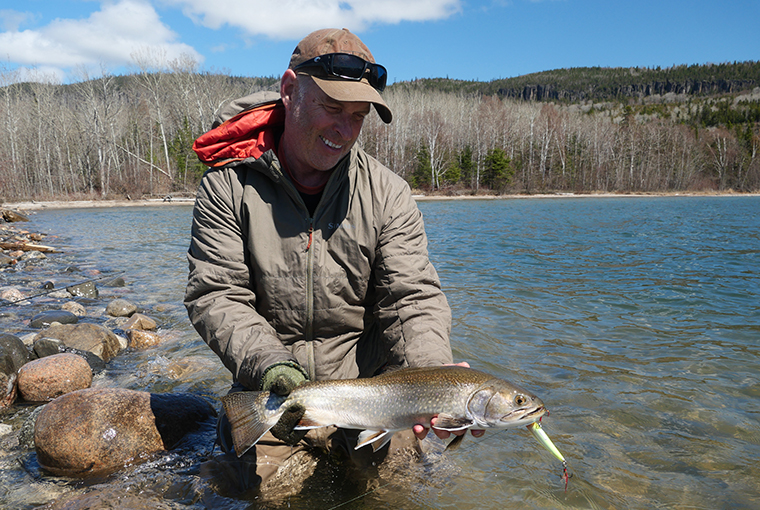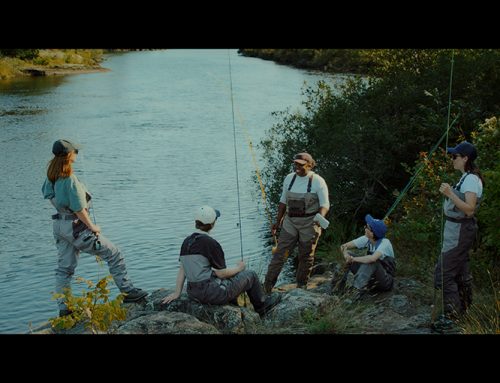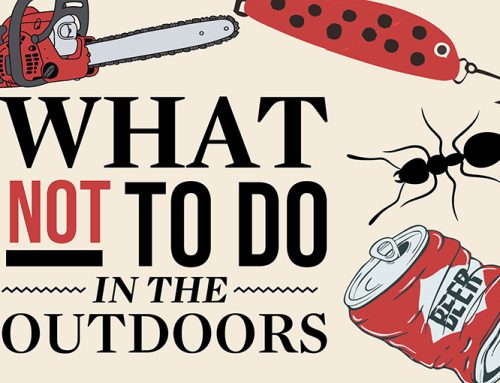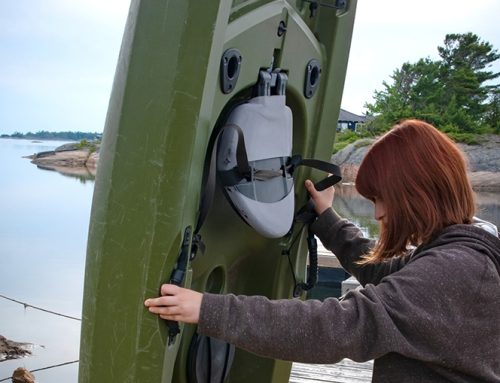
The first Lake Superior “coaster” brook trout I ever laid eyes on was in the refrigerator of a friend’s house in my hometown of Thunder Bay. It was in the mid-1970s and the trout had been cleaned and de-headed. Four times the size of any brook trout I had seen to that point, it was probably in the four-pound range. That coaster was caught by my friend’s father in the mouth of the Current River, on the north side of the city. Coasters were already rare at that point.
I would not see a brookie like it again for many years.
Coaster brook trout on Nipigon Bay
My first coaster of any size was taken about a decade after I saw that fridge trout. I was fishing Nipigon Bay with a buddy, and we were in a canoe owned by my father. The canoe had been rigged with a plywood bracket that could hold a four-horse Johnson outboard. Not the ideal rig for Lake Superior, but it was all we had available at the time.
We put in at a rocky bay in the late afternoon and made our way a couple of miles down the lake to a series of points. Once in casting range, my friend and I began chucking spoons at the shoreline and slowly working them back. It was early June, and the water was clear, cold, and calm. The sense of expectation was building with each cast. My partner hooked the first fish, a scrappy trout of about 15 inches. It was bright and silvery, which was a surprise.
More lake than brookie
As we continued down the shore, the boulders became larger and many of them were sitting well out in the water. In the shadow of these rocks, the water was dark, and the visibility limited. My Torpedo spoon landed on the shallow edge of the rocks and after a couple of reel cranks, there was a hard strike. It felt more like a lake trout than brookie.
When the fish passed under the canoe, my friend and I both could see this was no laker. The whiteness of the leading edge of the fins was visible, and the body shape was all brook trout. I cannot recall what was said, but that fish was netted and celebrated with some photographs I still have. The coaster was 20-inches long and pushing four pounds. It was a thrilling experience and a memorable day.
Coaster changes
Quite a few things have changed since that day in the mid-1980s. One major difference is the size and bag limit are now radically different for Lake Superior coasters. In the 1980s, the limit on brook trout was five fish any size and that helped to severely deplete the population.
Big brookies became rare.
Today the limit is one fish that must be 22 inches or over. It cannot be overstated what a difference that regulation has made. There is a history to how and why the size regulation came to be, and I was on the committee that developed it. Now-retired MNR Nipigon biologist Rob Swainson was a key player in the coaster comeback and deserves many thanks from all Nipigon trout anglers. It was his vision and perseverance that saved the coaster.
Moving to the big lake
The key thing to understand is that a 22-inch brook trout has spawned three times. So, if you must kill one (and please don’t), at least it has had a few chances to breed.
This coaster brook trout regulation also covers all Ontario side Lake Superior tributaries to the first falls or obstruction. This protects not only mature coasters that come into rivers to spawn and feed, but the smaller brook trout that will return to Superior. Genetic work has shown that small brook trout in tributaries have the same DNA as coasters.
Once they move to the big lake, the fish start to grow.
Catch and release of large brook trout is especially effective in the cold, clear water of Lake Superior. Tagging has shown that many fish are caught multiple times. When the conservation-focused regulations came into effect in the early 2000s, Nipigon Bay was the last stronghold of the coaster. Most of the north shore of Superior had very few coaster brookies and on the American side they were nearly gone.
Success stories
One of the real success stories connected with the regulation change is the gradual spread of coaster brook trout back into areas where they had not been seen for years.
A few years ago, a brook trout angler fishing close to the American border caught two coaster brook trout in one afternoon while trolling. One was 25 inches, while the other was 27 inches. These are massive brook trout anywhere in the world. A testament to the size and quality coasters can grow to if allowed to survive.
Last spring, nearly 40 years after that first trip to Nipigon Bay, I found myself back on that piece of shoreline I’d once fished in a canoe with a kicker. The place brought back a flood of memories and filled me with a familiar sense of expectation.
While my guest anglers cast flies off the front of the boat, I ran the front trolling motor and dragged a fly line behind the boat. The rod was rigged up with a floating line, and I had a Shimmer Smelt fly. The fly pulsed just below the surface and, as we moved between some huge sunken boulders, the fly rod pulled back and the click drag sounded off.
Back to the depths
“There’s a fish” I said grabbing the rod and strip setting the hook. This brookie stayed deep, rubbing the line on the boulders in a most dangerous manner. One of my guests grabbed the net and did a fine job hooping the coaster for me. The sides of the 22-inch trout were shiny, like a steelhead, yet you could see the spots and purple halos if you looked closely. There was a little red evident on the belly and fins, but nothing like you would see in a creek fish. The hook was dislodged, and the big trout was carefully released back to the depths.
I felt a rush that had electrified me four decades earlier. No native fish from Lake Superior has proven to be more of a survivor than the coaster brook trout. In my estimation, it is our greatest game fish.
Today the limit is one fish that must be 22 inches or more. It can-not be over-stated what a difference that regulation has made.
Lake Superior’s coaster brook trout can be fished from shore with basic spinning gear.
Originally published in the August 2024 issue of Ontario OUT of DOORS






Leave A Comment